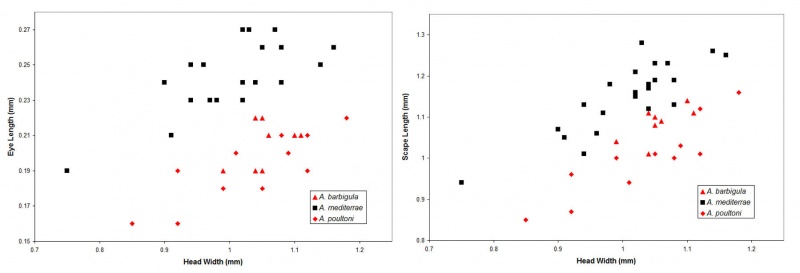Key to Australian Aphaenogaster Species
The following key to Australian Aphaenogaster is based on Shattuck (2008).[1]
1: Hairs under head
- Majority of hairs on venter of head located laterally and forming a distinct psammophore, only scattered hairs on central portion => 2

(Leads to: Aphaenogaster barbigula, Aphaenogaster mediterrae, Aphaenogaster poultoni)
- Hairs on venter of head randomly distributed and not forming a distinct psammophore => 3

(Leads to: Aphaenogaster barbara, Aphaenogaster kimberleyensis, Aphaenogaster longiceps, Aphaenogaster pythia, Aphaenogaster reichelae)
2: Eye size, scape length
- Eye relatively large (EI greater than 21); scape relatively long (SI greater than 106) => Aphaenogaster mediterrae
- Eye relatively small (EI less than 21); scape relatively short (SI less than 106) => 4
(Leads to: Aphaenogaster barbigula, Aphaenogaster poultoni)
3: Shape of head
- Posterior margin of head nearly flat in full face view, extending laterally of the occipital collar before passing through a distinct posterolateral corner into the lateral margin of the head => 5

(Leads to: Aphaenogaster pythia, Aphaenogaster reichelae)
- Posterior margin of head broadly arched in full face view, the arch beginning at the occipital collar and with at most a weak angle separating the posterior and lateral margins of the head (often posterior and lateral margins forming a continuous surface) => 6

(Leads to: Aphaenogaster barbara, Aphaenogaster kimberleyensis, Aphaenogaster longiceps)
4: Petiolar shape, mandibular sculpturing
- Petiolar node (in dorsal view) wider than long; mandibular sculpture composed of irregularly sized striations (occurring in Western Australia) => Aphaenogaster poultoni
- Petiolar node (in dorsal view) approximately square; mandibular sculpture composed of regularly sized striations (occurring in South Australia and eastward) => Aphaenogaster barbigula
5: Scape length
- Scape relatively short (SI less than 125) (occurring in eastern Queensland and north eastern New South Wales) => Aphaenogaster pythia
- Scape relatively long (SI greater than 135) (occurring in Northern Territory) => Aphaenogaster reichelae
6: Hair shape, propodeal spines
- Shorter erect hairs on mesosomal dorsum (especially those on mesonotum) with blunt tips; dorsal surfaces of propodeum and propodeal spines connected through a gentle concavity (so that the base of each spine is at approximately the same level as the dorsal surface of the propodeum) => Aphaenogaster longiceps
- Erect hairs on mesosomal dorsum tapering to sharp points; dorsal surfaces of propodeum and propodeal spines connected through a gentle concavity followed by a gentle convexity (so that the base of each spine is raised slightly above the dorsal surface of the propodeum) => 7

(Leads to: Aphaenogaster barbara, Aphaenogaster kimberleyensis)
7: Head shape, scape length
- Head relatively narrow, scape relatively long (occurring in northern Northern Territory and northern Western Australia) => Aphaenogaster kimberleyensis
- Head relatively broad, scape relatively short (occurring in Queensland) => Aphaenogaster barbara
References
- ↑ Shattuck, S. 2008. Australian ants of the genus Aphaenogaster (Hymenoptera: Formicidae). ZooTaxa 1677:25-45.







